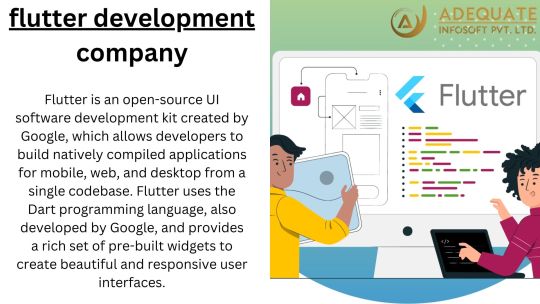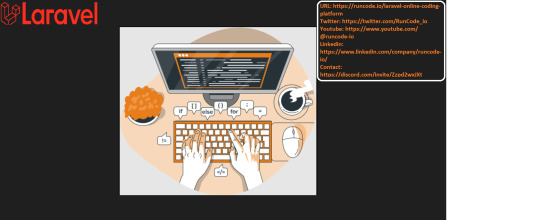#Laravel framework
Explore tagged Tumblr posts
Text
Top 5 Common Database Design patterns in Laravel
In the world of Laravel development, a well-structured database is the bedrock of a robust and scalable application. While Laravel's Eloquent ORM provides a powerful abstraction layer for interacting with your data, understanding common database design patterns can significantly enhance your development process.
These patterns not only promote code organization and maintainability but also enable you to adapt your database structure to the unique needs of your application. By mastering these patterns, you can build efficient, reliable, and easily maintainable Laravel applications that can handle diverse data requirements.
1. Active Record Pattern:
This is the most common pattern used by Eloquent ORM in Laravel. It encapsulates database logic within model classes, allowing you to interact with the database using object-oriented methods.
Application
This pattern is well-suited for projects of any size and complexity. It simplifies database operations, making them easier to understand and maintain.
Example:

Advantages:
Simplicity: Easy to understand and implement.
Code Reusability: Model methods can be reused throughout your application.
Relationship Management: Built-in support for relationships between models.
Disadvantages:
Tight Coupling: Model logic is tightly coupled to the database, making it harder to test independently.
Complexity: Can become complex for large applications with complex data structures.
2. Data Mapper Pattern:
This pattern separates data access logic from domain logic. It uses a dedicated "mapper" class to translate between domain objects and database records.
Application
This pattern is useful for large-scale applications with complex domain models, as it allows for greater flexibility and modularity. It is particularly useful when working with multiple data sources or when you need to optimize for performance.
Example:

Advantages:
Flexibility: Easily change the database implementation without affecting business logic.
Testability: Easy to test independently from the database.
Modularity: Promotes a modular structure, separating concerns.
Disadvantages:
Increased Complexity: Requires more code and might be overkill for simple applications.
3. Repository Pattern:
This pattern provides an abstraction layer over the data access mechanism, offering a consistent interface for interacting with the database.
Application
This pattern promotes loose coupling and simplifies testing, as you can easily mock the repository and control the data returned. It is often used in conjunction with the Data Mapper pattern.
Example:

Advantages:
Loose Coupling: Decouples business logic from specific data access implementation.
Testability: Easy to mock repositories for testing.
Reusability: Reusable interface for accessing different data sources.
Disadvantages:
Initial Setup: Can require more setup compared to Active Record.
4. Table Inheritance Pattern:
This pattern allows you to create a hierarchical relationship between tables, where child tables inherit properties from a parent table.
Application
This pattern is useful for creating polymorphic relationships and managing data for different types of entities. For example, you could have a User table and separate tables for AdminUser and CustomerUser that inherit from the parent table.
Example:

Advantages:
Polymorphism: Enables handling different types of entities using a common interface.
Code Reusability: Reuses properties and methods from the parent table.
Data Organization: Provides a structured way to organize data for different types of users.
Disadvantages:
Increased Database Complexity: Can lead to a more complex database structure.
5. Schema-less Database Pattern:
This pattern avoids the use of a predefined schema and allows for dynamic data structures. This is commonly used with NoSQL databases like MongoDB.
Application
This pattern is suitable for projects that require highly flexible data structures, such as social media platforms or analytics systems.
Example:

Advantages:
Flexibility: Easily adapt to changing data structures.
Scalability: Suitable for high-volume, rapidly changing data.
High Performance: Efficient for specific use cases like real-time analytics.
Disadvantages:
Increased Complexity: Requires a different approach to querying and data manipulation.
Data Consistency: Can be challenging to maintain data consistency without a schema.
Choosing the Right Pattern:
The best pattern for your project depends on factors like project size, complexity, performance requirements, and your team's experience. It is important to choose patterns that align with the specific needs of your application and ensure long-term maintainability and scalability.
Conclusion:
This exploration of common database design patterns used in Laravel has shed light on the importance of strategic database structuring for building robust and scalable applications. From the simplicity of the Active Record pattern to the sophisticated capabilities of the Data Mapper and Repository patterns, each pattern offers distinct benefits that cater to specific project needs.
By understanding the strengths and applications of these patterns, Laravel developers can choose the optimal approach for their projects, ensuring a well-organized, efficient, and maintainable database architecture. Ultimately, mastering these patterns empowers you to create Laravel applications that are not only functional but also adaptable to evolving data requirements and future growth.
#laravel#laravel development company#laravel framework#laravel developers#database#design#coding#programming
4 notes
·
View notes
Text
How Online Office Furniture Platforms Verify Accounts Using Laravel Events, Jobs and Queues
Have ever wondered how just a simple online office furniture store verifies you account you registered using an email address? For sure, they use Laravel which is the currently the best PHP framework. It offers programmers and web developers with advanced tools to integrate tech in and build secure web developments. Here, they automate your email verification using Laravel Events, Jobs and Queues combinations to your inbox. Then after, you can securely receive the latest updates about the trendy office chairs and desks, keep all your office furniture order information. For sure, this also keeps office furniture manufacturers and suppliers at a cutting-edge as they securely and safely offer online services.
Here is how.
#Laravel#Laravel framework#office furniture#tech integration#modern office furniture#ergonomic chairs#office chairs#trendy office chairs#office desks#furniture manufacturers#PHP Framework#account verification#email verification#order information#secure platforms#online office furniture store#Office furniture Dubai#cutting edge office furniture#web development#web design#online services#office furniture suppliers#register email address#Laravel Events#Laravel jobs#Laravel Queues#advanced web development#advanced online systems#secure web developments#web security
0 notes
Text

Laravel is one of the most popular PHP frameworks for web development. It offers powerful features for developers with a simple UI that makes it simple to use. If you are starting with a PHP framework or planning a web application, Laravel can be your best choice. It makes the development process faster and easier.
#laravel framework#php frameworks#laravel development services#laravel web development#php development services#best php framework#laravel developer
0 notes
Text
Select the best Laravel development tools from PhpStorm, Debugbar, Forge, Dusk, Vapor, Tinker, and Socialite, to build dynamic and scalable web apps.
#Laravel#Laravel Framework#Laravel Development#PHP#Laravel Tool#Php Developers#Hire Laravel Developer#Docker#Laradock
0 notes
Text
Laravel vs. Node.js - Choosing the Best Framework for 2024 Development Needs

Introduction
Web development is evolving at a breakneck pace, and choosing the right framework can make or break your project. Laravel, a PHP framework, and Node.js, a JavaScript runtime, are two of the most popular choices. Both have their strengths and weaknesses, and your choice should depend on the specific needs of your project. Let's dive in to see how they stack up against each other for 2024 development needs.
Overview of Laravel
Laravel is an open-source PHP web framework known for its elegant syntax and robust features. It simplifies tasks like routing, authentication, and caching, making web development a more enjoyable experience.
Key Features of Laravel
Blade Template Engine
Laravel's Blade template engine allows for clean and dynamic code through control structures like loops and conditional statements. It enhances views by integrating multiple templates into a single data model.<!-- Example of Blade Template Engine --> @if (count($records) === 1) I have one record! @elseif (count($records) > 1) I have multiple records! @else I don't have any records! @endif
Eloquent ORM
Eloquent ORM (Object-Relational Mapping) enables developers to work with databases using PHP syntax instead of SQL. This feature makes database interaction more efficient and less error-prone.// Example of Eloquent ORM $user = User::find(1); $user->name = 'John Doe'; $user->save();
Built-in Packages
Laravel comes with pre-configured packages that simplify coding and maintain a healthy website. For instance, the Socialite package integrates social media authentication into your application.// Example of using Socialite for Google Authentication return Socialite::driver('google')->redirect();
Artisan Command-Line Tool
Artisan is Laravel's command-line interface, which helps automate repetitive tasks like database migrations, code generation, and more.# Example of Artisan command php artisan make:model Post
Use Cases of Laravel
SaaS-based web applications
E-Learning platforms
On-demand video streaming
Stock trading applications
Multi-lingual CMS systems
Overview of Node.js
Node.js is an open-source, cross-platform JavaScript runtime environment. It excels in building scalable network applications, thanks to its non-blocking, event-driven architecture.
Key Features of Node.js
Asynchronous and Event-Driven
Node.js operates on an asynchronous, event-driven model, allowing it to handle multiple operations simultaneously.// Example of asynchronous function in Node.js fs.readFile("file.txt", "utf8", (err, data) => { if (err) throw err; console.log(data); });
Full-Stack Capabilities
Node.js is designed to execute JavaScript code on both the server and client sides, making it ideal for full-stack development.// Example of a simple Node.js server const http = require("http"); const server = http.createServer((req, res) => { res.statusCode = 200; res.setHeader("Content-Type", "text/plain"); res.end("Hello World\n"); }); server.listen(3000, "127.0.0.1", () => { console.log("Server running at http://127.0.0.1:3000/"); });
Cross-Platform Compatibility
Node.js is compatible with various operating systems, including Windows, macOS, Linux, and Unix. It can even be used for mobile development.
Fast Data Streaming
Node.js excels in real-time data streaming, making it ideal for applications requiring quick data transfer.// Example of data streaming in Node.js const fs = require("fs"); const readableStream = fs.createReadStream("file.txt"); const writableStream = fs.createWriteStream("file-copy.txt"); readableStream.pipe(writableStream);
IoT Protocol
Node.js supports the MQTT protocol, making it suitable for IoT applications.
Read More
0 notes
Text
Elevate your web development projects with our Laravel development services. Our team of experienced developers specializes in building high-performance web applications using the Laravel framework. From custom web solutions to e-commerce platforms, we deliver robust and scalable solutions tailored to your needs.
0 notes
Text
Laravel Vs Node Js: Which one is better?

Confused about Laravel vs Node JS? This guide explores their strengths, use cases, and helps you pick the right technology for your project.
#laravel#nodejs#node#laravel framework#laravel developers#laravel development services#nodejs development
1 note
·
View note
Text
What is Laravel? Unveiling the Power of PHP Frameworks

Laravel is a distinguished PHP framework celebrated for streamlining web development by automating common tasks such as routing, authentication, and caching.
For those asking, "What is Laravel development?" it's about leveraging a framework that facilitates a more efficient and less cumbersome development process.
Key Attributes of the Laravel PHP Framework:
MVC Architecture: At its core, Laravel uses a Model-View-Controller architecture that helps in organizing code effectively, segregating business logic from UI concerns, which in turn boosts developer efficiency and code maintainability.
Eloquent ORM: A standout feature of the Laravel framework is its ORM (Object-Relational Mapping) system, known as Eloquent. This system simplifies interactions with the database using an expressive syntax that is both intuitive and robust, enhancing database management and operations.
Blade Templating: Laravel's Blade templating engine integrates seamlessly with common PHP code to optimize tasks like data handling and display, enriching the overall flexibility and power of Laravel framework development.
Database Migration Systems: Laravel streamlines database version control and schema updates with its migration system, facilitating easy adaptation to changes while promoting collaboration among developers.
Robust Security Measures: The framework includes built-in mechanisms to protect against common security threats such as SQL injection and XSS, ensuring that Laravel framework development is secure right from the outset.
For those exploring modern PHP development, understanding "What is Laravel?" reveals a framework designed not just for efficiency but also for security and scalability. Laravel's comprehensive tools and features make it an excellent choice for crafting sophisticated, well-structured web applications.
0 notes
Text
#digital aptech#laravel#laravel web development services#laravel development services#laravel development company#laravel framework#web development#web development company#web development services#web developers
0 notes
Text
How Send WhatsApp Messages in Laravel 11 Using Twilio
Adding WhatsApp messaging to websites can really improve how users communicate. In Laravel 11, using Twilio’s powerful tools makes it easy for developers to send WhatsApp messages right from their apps.
This tutorial guides you through the whole process of sending WhatsApp messages in Laravel 11 with Twilio. It’s a great way for developers to add WhatsApp features to their apps, making communication more personal and automated.

0 notes
Text

Laravel development company is robust and reliable whereas PHP in comparison to Laravel is slightly outdated and slow. Additionally, Laravel is an open-source framework that follows MVC architecture and is quite fast hence it is widely used to design custom websites and applications
0 notes
Text
Solution to Laravel "table.cache Doesn't Exist"
Hey! as of recently, was implementing an e-commerce online office furniture store while using my favorite PHP Laravel framework. I landed on this "table.cache doesn't exist" error which took me time to realize that I was accessing a table which wan not yet created. So i had to correct this configuration setting and also create a table for storing the cached data. You no longer need to reinvent the wheel. A full guide to how to resolve Laravel "Table.Cache Doesn't Exist" is here.
#laravel#office furniture#online store#programming error#configuration solution#Resolve error#debugging#Debug Laravel#Laravel Config file#Laravel Framework#database#env file#config cache php#programming#deployment#ecommerce
0 notes
Text
Laravel with our comprehensive guide crafted by RND experts. From beginner basics to advanced techniques, master Laravel development and build robust web applications efficiently.
1 note
·
View note
Text

Laravel Online Coding Platform - RunCode
RunCode offers a dedicated Laravel development environment for developers. Its robust environment facilitates quick prototyping, testing, and debugging of Laravel applications, making it an ideal choice for both beginners and experienced developers seeking an efficient, accessible, and collaborative Laravel development solution. For more information visit the website https://runcode.io/laravel-online-coding-platform
0 notes
Text
Laravel 9 CRUD Application Tutorial with Example

Laravel is one of the most popular PHP frameworks for web development, known for its simplicity and expressive syntax. In this tutorial, we will be building a basic CRUD (Create, Read, Update, Delete) application using Laravel 9. We will start by setting up the Laravel 9 environment, creating a database, and then building the CRUD application.
Setting up Laravel 9 Environment
To begin with, we need to install Laravel 9 on our system. We can do this using Composer, a PHP package manager. Open up a command prompt and run the following command:composer create-project --prefer-dist laravel/laravel laravel-crud
This will create a new Laravel 9 project named "laravel-crud". We can navigate to this directory by running the following command:cd laravel-crud
Creating a Database
Next, we need to create a database for our CRUD application. We can do this by using phpMyAdmin or any other database management tool. Once we have created the database, we need to update our Laravel 9 application's .env file with the database credentials:DB_CONNECTION=mysql DB_HOST=127.0.0.1 DB_PORT=3306 DB_DATABASE=laravel_crud DB_USERNAME=root DB_PASSWORD=
Creating a Model and Migration
Now, we will create a model and migration for our CRUD application using the following command:php artisan make:model Product -m
This will create a model named "Product" and a migration file for the "products" table in our database. We can update the migration file with the following code:public function up() { Schema::create('products', function (Blueprint $table) { $table->id(); $table->string('name'); $table->text('description'); $table->float('price'); $table->timestamps(); }); }
The above code will create a "products" table with columns for "name", "description", "price", and "timestamps". We can run the migration using the following command:php artisan migrate
Creating a Controller
Next, we will create a controller for our CRUD application using the following command:php artisan make:controller ProductController --resource
This will create a controller named "ProductController" with resourceful methods for our CRUD operations. We can update the controller with the following code:public function index() { $products = Product::latest()->paginate(5); return view('products.index', compact('products')) ->with('i', (request()->input('page', 1) - 1) * 5); } public function create() { return view('products.create'); } public function store(Request $request) { $request->validate([ 'name' => 'required', 'description' => 'required', 'price' => 'required' ]); Product::create($request->all()); return redirect()->route('products.index') ->with('success', 'Product created successfully.'); } public function show(Product $product) { return view('products.show', compact('product')); } public function edit(Product $product) { return view('products.edit', compact('product')); } public function update(Request $request, Product $product) { $request->validate([ 'name' => 'required', 'description' => 'required', 'price' => 'required' ]); $product->update($request->all()); return redirect()->route('products.index') ->with('success', 'Product updated successfully'); } public function destroy(Product $product) { $product->delete(); return redirect()->route('products.index') ->with('success', 'Product deleted successfully'); }
In the above code, we have created resourceful methods for our CRUD operations. The index() method fetches all products from the database and displays them in a paginated view. The create() method displays a form to create a new product. The store() method validates the request data and saves the new product to the database. The show() method displays a single product. The edit() method displays a form to edit an existing product. The update() method updates the product in the database with the new data. The destroy() method deletes a product from the database.
Read More
0 notes